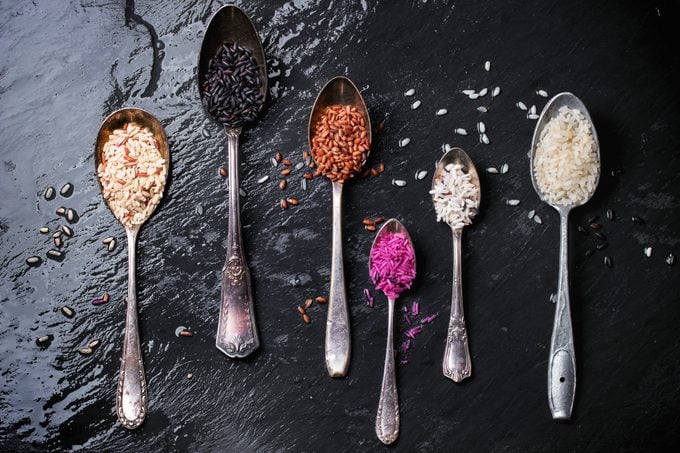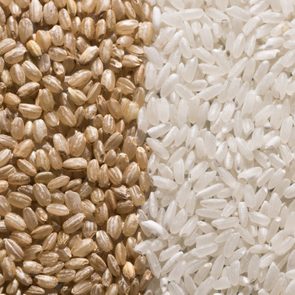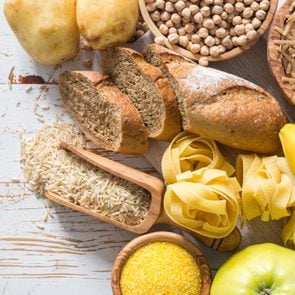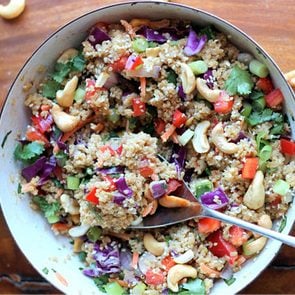5 Types of Rice: Which Is the Healthiest?
Updated: May 27, 2021
Sure, you know all about brown vs white rice. But do you know about the other varieties? A registered dietitian breaks down everything you need to know about all of these tasty carb options and whether rice is indeed healthy.
Is rice healthy?
It’s not your imagination: The rice section at your local grocery store has gotten a whole lot more interesting. Shelves of plain white rice are making room for brown rice, black rice, wild rice, even red rice. But are they all that different from one another when it comes to taste? How about nutrition?
As a starchy grain, rice is relatively high in carbohydrates. It’s also generally gluten-free. In the current keto-obsessed world, rice doesn’t exactly get the love it deserves.
Although there are healthy alternatives for foods like rice that nutritionists trust, rice itself is a perfectly healthy source of carbohydrates.
What happens when you eat rice?
When you eat rice, here’s what happens: The body converts the carbohydrates into glucose, a form of energy that the cells of the body use the most.
That glucose enters the bloodstream and signals the release of insulin. Insulin delivers the glucose in the blood to the cells.
It’s important to remember that our body’s cells take only the glucose they need. So when we eat more carbs than we need, excess glucose in the blood is not taken up by cells. Rather, it’s converted to glycogen, and stored for later use in the liver or muscles. The body may also convert this excess glucose into fatty acids and keep it as body fat.
Here’s the kicker: No matter what form or source of carbs you enjoy—whether it’s potato chips, ice cream, butternut squash, or bananas—the body still converts the carbohydrates into glucose. However, the nutritional content of those carbs and what you pair them with impacts the rate at which those carbs convert to glucose, and how they impact blood sugar.
Now, back to the different types of rice. In reality, there are 40,000 different types of rice (really!), including aromatic varieties like jasmine and basmati, as well those like arborio, which is a starchy rice used to make risotto. (Quinoa vs. rice: find out what’s different.)
For the purposes of comparison, we looked at five main categories of rice commonly found in supermarkets: white, brown, wild, black, and red rice. What’s the real difference among them? Answers ahead!

White rice
White rice is refined, meaning it has undergone processing that has removed the husk, bran, and wheat. In doing so, the grain is also stripped of fiber, B vitamins, and minerals.
Many white rice products are labeled “enriched,” which means that the B vitamins are added back, after initial processing, according to the Journal of Food Engineering.
It’s safe to say that white rice doesn’t give you the biggest bang for your nutritional buck. According to the Journal of Pharmacognosy and Phytochemistry, one cup of cooked white rice contains about 200 calories, 45 grams of carbohydrates, four grams of protein, and…that’s pretty much it. It’s not a significant source of fat, fiber, or any vitamins or minerals.
Here’s the thing with white rice: It’s essentially just carbs. But that doesn’t mean you should skip it altogether. It’s a perfectly healthy source of carbs. It just needs to be paired with other macronutrients and micronutrients to help keep blood sugar stable. A good rule of thumb: Try to include all three macronutrients (carbs, fats, protein) and veggies at every meal.
For example, a great way to give white rice an upgrade is to add it to, say, chicken curry made with coconut milk (protein and fat) and sautéed veggies (fiber). The protein and fat in the chicken curry and the fiber from the veggies will slow the breakdown and digestion of the carbs in the white rice, to make for a well-rounded meal.
Brown rice
Brown rice is actually white rice before all the processing. A full, untouched grain of rice has many layers. To make brown rice, only the outermost layer—called the hull—is removed. That’s why brown rice is a whole grain.
One cup of cooked brown rice has a very similar macronutrient breakdown to white rice:about 215 calories, five grams of protein, and little to no fat, according to Rice Grain Quality. However, brown rice breaks out the big gains in the micronutrient game.
Just one cup has about four grams of fiber, a significant amount of niacin, magnesium, phosphorus, and selenium, and almost 90 percent of our daily needs for manganese.
Manganese deserves the spotlight for a second. This mineral does a whole lot for us, yet it rarely gets the attention it deserves. Manganese is a component of manganese superoxide dismutase, the main antioxidant enzyme found in the mitochondria, according to the Journal of the American College of Nutrition.
This means that it assists in combatting the effects of oxidative stress throughout the body. Also, manganese is an all-star when it comes to bone health. It plays a crucial role in forming and maintaining healthy cartilage and bone.
When it comes to the effects that brown rice has on the body, they’re quite similar to white rice. In fact, all rice has a similar impact on the body. Again, the carbs are broken down into glucose, which enters the bloodstream, and goes to our cells.
However, since brown rice contains iron and is packed with fiber and micronutrients, that digestion process is a bit slower than it is with white rice.
Our advice remains: When adding brown rice to a meal, make sure all other macronutrients are at the party. Oh, and don’t forget your veggies.
Wild rice
Although it’s not quite as commonplace as white and brown rice, wild rice definitely deserves a seat at the table. Similar in nutrient profile to brown rice, one cup of wild rice contains about 166 calories, seven grams of protein, and three grams of fiber.
Remember all that talk about manganese? Wild rice has it, too. One cup cooked has about 23 percent of the daily recommended amount of manganese. It’s also packed with a significant amount of magnesium, zinc, and phosphorus.
The nuttiness of wild rice makes it a delicious addition to any meal, and one that stands up to bold flavors. Turn it into a nutty risotto, add it to a hearty soup, or use it as a side dish with roast chicken.
Black and red rice
Also called “forbidden rice,” black rice looks exactly as it sounds, except there’s nothing forbidding about it. According to the journal Food Chemistry, it gets its color from its high content of anthocyanins (flavonoids with powerful antioxidant effects). Dark fruits and vegetables like blueberries, blackberries, and eggplant are also chock full of these.
Although its popularity certainly began in Asian regions of the world, black rice has gained some traction in the United States. It can be found in many common grocery stores and restaurants. One note about black rice: Although the cooking technique is the same as most other rice varieties, black rice takes an extra 10 to 15 minutes to cook.
Remember those anthocyanins? According to the Journal of Agriculture and Food Chemistry, those show up in high amounts in red rice as well. Red rice is definitely less common than other varieties, but many specialty stores and health food stores carry it.
Those anthocyanins are what really step up the nutritional quality of both black and red rice. According to the journal Food & Nutrition Research, these potent compounds combat oxidative stress in the body.
Research shows that anthocyanins play a role in lowering blood pressure, preventing type 2 diabetes, and reducing inflammation throughout the body.
Similar to brown rice, one cup of cooked red or black rice has about 215 calories, 45 grams of carbohydrates, four grams of protein, three grams of fiber, and little to no fat.
These particular varieties of rice are known to have a nutty flavor. Black rice also has a very subtle sweetness. Add it to a stir fry with sauteed tofu, veggies, and coconut aminos.
It’s also delicious on top of fall salads (think: kale, butternut squash, pomegranate seeds, goat cheese, black rice, and balsamic vinaigrette). For red rice, try whipping up a red rice pilaf, with lots of sautéed veggies and fresh herbs. It makes for a healthy and delicious side dish.
Bottom line: All varieties of rice can fit into a healthy diet
We know, we know. You wanted us to pick a favorite. The truth is, all varieties of rice are relatively similar in the nutrition department. So they all have the potential to be healthy types of rice.
Our advice: When you can, choose rice with color (brown, wild, black, or red), and always pair it with a lean protein, healthy fats, and fiber-filled veggies.






















